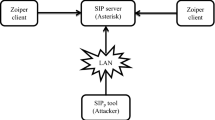Abstract
The advent of Voice over IP (VoIP) has offered numerous advantages but, at the same time, it has introduced security threats not previously encountered in networks with a closed architecture like the Public Switch Telephone Networks (PSTN). One of these threats is that of signaling attacks. This paper examines the signaling attacks in VoIP environments based on the Session Initiation Protocol (SIP), focusing on the design of a robust lightweight protection mechanism against them. The proposed scheme introduces a new SIP header, namely the Integrity-Auth header, which is utilized for protecting the SIP-based VoIP services from signaling attacks while ensuring authenticity and integrity.
Similar content being viewed by others
References
Sicker, D. C., & Lookabaugh, T. (2004). VoIP security: not an afterthought. QUEUE. New York: Assoc. Comput. Mach.
Gibson: Distributed reflection denial of service. On-line tutorial, http://grc.com/dos/drdos.htm.
Rosenberg, J., Schulzrinne, H., Camarillo, G., Johnston, A., Peterson, J., Spark, R., Handley, M., & Schooler, E. (2002). Session initiation protocol. RFC 3261, June 2002.
Hersent, O., Petit, J., & Gurle, D. (2005). IP telephony: deploying voice-over-IP protocols. New York: Wiley.
Andreasen, F., & Foster, B. (2003). Media Gateway Control Protocol (MGCP) Version 1.0. RFC 3435, January 2003.
Schulzrinne, H., Casner, S., Frederick, R., & Jacobson, V. (2003). RTP: A transport protocol for real-time applications. RFC 3550, July 2003.
VOIPSA (2005). VoIP security and privacy threat taxonomy. http://www.voipsa.org/Activities/taxonomy.php, October 2005.
Geneiatakis, D., Dagiuklas, T., Kambourakis, G., Lambrinoudakis, C., Gritzalis, S., Ehlert, K. S., & Sisalem, D. (2006). Survey of security vulnerabilities in session initiation protocol. IEEE Communications Surveys and Tutorials, 8(3), 68–81.
Wu, Y.-S., Bagchi, S., Garg, S., & Singh, N. (2004). SCIDIVE: a stateful and cross protocol intrusion detection architecture for voice-over-IP environments. In Proceedings of international conference on dependable systems and networks (Vol. 28, pp. 433–442). June 1–July 2004.
Cao, F., & Jennings, C. (2006). Providing response identity and authentication in IP telephony. In Proceedings of the first international conference on availability, reliability and security (Vol. 20–22, p. 8). April 2006.
Ethereal Sniffer, www.ethereal.com.
Salsano, S., Veltri, L., & Papalilo, D. (2002). SIP Security Issues: The SIP authentication procedure and its processing load. IEEE Network, 16(6), 38–44.
Geneiatakis, D., Dagiuklas, T., Kambourakis, G., Lambrinoudakis, C., & Gritzalis, S. (2005). Session initiation protocol security mechanisms: a state-of-the-art review. INC’05 International Network Conference, July 2005 (pp. 147–156).
Rescorla, E. (2000). SSL and TLS—designing and building secure systems (1st ed.). Reading: Addison-Wesley.
Ramsdell, B. (2004). Secure/Multipurpose Internet Mail Extensions (S/MIME) Version 3.1 message specification. IETF RFC 3851, July 2004.
Franks, J., Hallam-Baker, P., Hostetler, J., Lawrence, S., Leach, P., Luotonen, A., & Stewart, L. (1999). “HTTP authentication: basic and digest access authentication” IETF. RFC 2617, June 1999.
Yang, C.-C., Wang, R.-C., & Liu, W.-T. (2005). Secure authentication scheme for session initiation protocol. Computers and Security, 24(5), 381–386.
Dagiuklas, T., Geneiatakis, D., Kambourakis, G., Sisalem, D., Ehlert, S., Fiedler, J., Markl, J., Rokos, M., Botron, O., Rodriguez, J., & Liu, J. (2005). “General reliability and security framework for VoIP” infrastructures. http://www.snocer.org, August 2005.
Niccolini, S., Garroppo, R. G., Giordano, S., Risi, G., & Ventura, S. (2006). SIP intrusion detection and prevention: recommendations and prototype implementation. In Proceedings of 1st IEEE workshop on VoIP management and security (Vol. 3, pp. 47–52). April 2006.
Chen, E. Y. (2006). Detecting DoS attacks on SIP systems. In Proceedings of 1st IEEE workshop on VoIP management and security (Vol. 3, pp. 53–58). April 2006.
Krawczyk, H., Bellare, M., & Canetti, R. (1997). HMAC: Keyed-Hashing for message authentication. RFC 2104, February 1997.
Jablon, D. P. (1997). Strong password-only authenticated key exchange. ACM SIGCOMM, Computer Communication Review, p. 526.
Gupta, P., & Shmatikov, V. Security analysis of voice-over-IP protocols. Available on http://citeseer.ist.psu.edu/761544.html.
The LynxPhone, http://www.bitlynx.com/lynxphone.php.
Minisip, http://www.minisip.org.
Snom 300, http://www.snom.com.
Schulzrinne, H., Oran, D., & Camarillo, G. (2002). The reason header field for the session initiation protocol. RFC 3326, Internet Engineering Task Force.
Niccolini, S., Tartarelli, S., Stiemerling, M., & Srivastava, S. SIP extensions for SPIT identification. Work in progress available on http://tools.ietf.org/html/draft-niccolini-sipping-feedback-spit-03.
Willis, D., & Hoeneisen, B. (2002). Session Initiation Protocol (SIP) extension header field for registering non-adjacent contacts. RFC 3327.
Garcia-Martin, M., Henrikson, E., & Mills, D. Private header (P-Header) extensions to the Session Initiation Protocol (SIP) for the 3rd-Generation Partnership Project (3GPP). RFC 3455.
Author information
Authors and Affiliations
Corresponding author
Rights and permissions
About this article
Cite this article
Geneiatakis, D., Lambrinoudakis, C. A lightweight protection mechanism against signaling attacks in a SIP-based VoIP environment. Telecommun Syst 36, 153–159 (2007). https://doi.org/10.1007/s11235-008-9065-5
Published:
Issue Date:
DOI: https://doi.org/10.1007/s11235-008-9065-5




